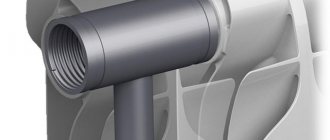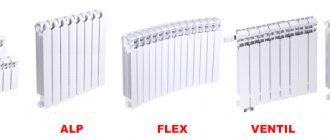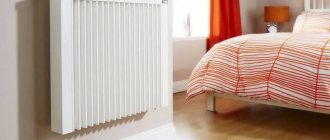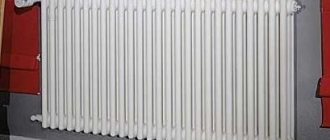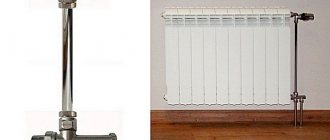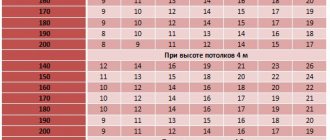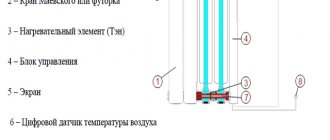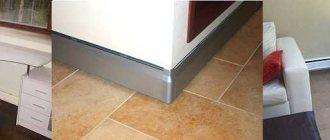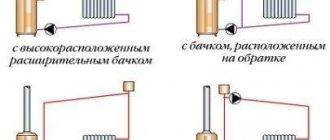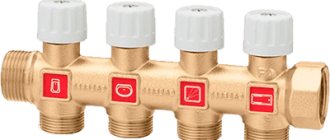The heating system is one of the most important aspects on which the comfort of being in the house depends. It is with its correct installation and configuration that the heat transfer will be high and the percentage of energy loss will be minimal. But in addition to these parameters, it is also worth paying attention to the choice of radiator - it is its characteristics that determine the final efficiency and durability of the system.
Bimetallic heating batteries have priority in this segment: the sizes and types of these solutions are varied, and the parameters are most suitable for all possible use scenarios. Installation of radiators of this type is appropriate for both residential premises (private houses and apartments) and offices.
Combining the advantages of other types of batteries, bimetallic solutions look attractive from both a practical and financial point of view. They will save money both on utility bills and on system maintenance. But do these radiators have their own disadvantages and how critical are they? This article will help you make your choice.
Advantages and disadvantages of bimetallic radiators
Let's consider the advantages and disadvantages of bimetallic heating radiators compared to cast iron and aluminum counterparts. For a fair comparison, let’s take the three most popular and best-selling models. Among bimetallic solutions, buyers consider Royal Thermo PianoForte 500/Bianco Traffico for 10 sections to be the most attractive. Aluminum batteries in this comparison will be represented by the Alecord 350/80 model with the same number of segments. Among cast iron radiators, the recognized leader in sales is STI Nova 500.
Design and principle of operation of cast iron radiators
For decades, people have been using cast iron radiators to heat their homes. Many people strongly associate them with quality and durability. Cast iron batteries are excellent for installation in houses with individual heating, and for use in apartments where heating is centralized and the pressure is about 25 atmospheres.
For the production of modern cast iron batteries, ductile cast iron is used, which is an analogue of the material for the production of cookware.
By design, cast iron models are batteries consisting of separate sections connected by nipples. The nominal dimensions of the heat flow, battery dimensions and number of sections may directly depend on the manufacturer.
The most vulnerable places in heating devices that operate under high pressure are the joints. Cast iron batteries have a minimum number of connection points due to the cast structure.
They also have a larger flow section diameter, which makes it possible to better cope with various types of contaminants that enter the coolant along with water.
Weight
Here the bimitallic Royal Thermo PianoForte 500/Bianco Traffico has no advantage - the weight of a battery of ten sections will be 22 kilograms. Its aluminum competitor wins in this indicator by almost two and a half times, its weight is almost 9 kg. However, this loss does not look so serious against the background of the cast-iron STI Nova 500 - this battery is heavier than both competitors combined. Her weight is 42 kilograms.
Of course, weight is far from the most important parameter if you set out to choose the best coolant. Manufacturers of bimetallic heating radiators do not pay too much attention to this, focusing on the volume of sections and heat capacity. In practical use, this parameter also has little effect - except that a heavier battery requires better installation of the fasteners.
How to distinguish an aluminum radiator from a bimetallic one
In life we have to deal with things that are difficult to understand at first glance. One such case is the problem of visual differences between bimetallic and aluminum radiators. After all, it would seem outwardly identical, but their characteristics and prices are different. Therefore, in order not to be deceived by the seller in the store or the craftsmen who install heating in your home, you need to distinguish between these types of radiators.
General structure of a bimetallic and aluminum radiator
To understand them, you first need to understand how each of these types of radiators works.
Aluminum radiator
Consists of homogeneous aluminum metal. Not pure, but alloyed with silicon for strength. It is cast in a special mold in sections or, less often, in blocks. The sections are screwed together using a threaded connection using a gasket to seal the joint.
The design of the section itself is designed in such a way that when assembled, several sections form petals with convection passages for better heat transfer.
Bimetallic radiator
As already mentioned, it is similar in appearance to aluminum, but there is a difference in the device. The internal part of the radiator section consists of horizontal and vertical steel pipes. Horizontal pipes are larger in diameter than vertical pipes. The outside of the pipes is “clad” in aluminum. The design of the aluminum “fur coat” is also ribbed, like that of all-aluminum ones.
Hence the external similarity. The sections are also screwed together using a threaded connection using a gasket. The individual tubes of the sections form a system of tubes in the form of a collector, which is designed to circulate coolant through it.
Since steel is much stronger than aluminum, bimetallic radiators can withstand much greater pressure and water hammer.
How to distinguish when purchasing
Now, knowing the design of both radiators, they won’t sell you aluminum radiators under the guise of bimetallic ones.
Pay attention to the place of the radiator where there is a thread for connecting the sections. In a bimetallic radiator, threads are cut into a steel pipe
Therefore, steel differs from aluminum in color; you can often observe the boundary of the two metals, again in the area of the thread (but sometimes this transition is not visible). Compare the weight of a bimetallic radiator with the weight of an aluminum radiator with the same size and equal number of sections. Steel is heavier than aluminum, so the weight of one section
bimetal can weigh up to half a kilogram more than its “double”. But in general, this difference will be sensitive even without the use of scales.
How to distinguish an already installed radiator
Imagine a situation where you hired a team to install a heating system, they installed it completely, they purchased all the materials themselves. You missed the moment when the radiators were not yet installed. Doubts have crept into your mind whether they installed aluminum batteries instead of bimetallic ones. This fact needs to be verified to dispel all doubts.
To do this, take a magnet, preferably neodymium. He is much stronger than others. But it can also be ordinary.
Bring the magnet somewhere on the edge of the radiator closer to its center, instead of as close as possible to the intended passage of the metal pipe. Steel is attracted to a magnet; aluminum does not have this property. Therefore, a bimetallic radiator will experience a slight attraction, since the magnet will not be located close to the pipe, but at some distance due to the aluminum shell surrounding it.
By the way, you can use a magnet on an uninstalled radiator by bringing it to the thread for connection. The effect of attraction will be clearly felt here if it is a bimetal.
Now knowing the differences in the design features and properties of these types of radiators, it will be impossible to deceive you and you will feel their warmth in your home for many years to come.
Heat capacity
Of course, the main parameter when choosing a radiator is the ability to receive and release heat. The higher it is, the more economical and efficient the system as a whole will be. Heat output is essentially the power of the battery - the same units (watts) are even used to measure it.
The cast iron radiator STI Nova 500 for 10 sections boasts a power rating of 1500 W. With a slight margin, which can be attributed to an error, it is ahead of the aluminum solution from Alerecord with an indicator of 1550 watts. It is the bimetallic solution that gets the palm - this radiator is capable of delivering 1850 W. It would seem that we can already say with confidence which battery is better: aluminum or bimetallic, but we should not rush to conclusions. A huge role in the operation of the radiator is also played by the ability to withstand high temperature changes, as well as the ability to withstand high pressure.
Which is better - aluminum or bimetallic?
When choosing between an aluminum and bimetallic radiator, it is worth knowing the features of each. Bimetallic radiators are practically no different in use from aluminum ones. That is why they are used in high-rise apartments and offices, as well as in enterprises. They are also often installed in private houses and cottages, but if we talk about feasibility, closed heating systems create up to 2 atmospheres, and therefore the use of aluminum analogues is considered more justified.
Aluminum appliances are imported mainly from Italy, and bimetallic appliances enter the market from China. Therefore, one can only guess about the quality of not only welding, but also materials. But it’s worth understanding each type of device in more detail to decide which radiator is better in your case – aluminum or bimetallic.
Cladding the basement of a house - which material is better?
How to choose and install a wireless video peephole
Working with coolant
As for working with coolant, there are two main characteristics that should be taken into account first: the boundary pressure at which the radiator will operate and the maximum temperature of the liquid.
For the STI Nova 500, these figures are 14 atmospheres and 130 degrees Celsius, respectively. The aluminum radiator Royal Thermo PianoForte 500/Bianco Traffico can please you with a working pressure of 16 atm, and in critical situations it can withstand 24 atmospheres. In this case, the limit temperature will be a more modest 95 degrees - this is the standard for this type of battery.
The bimetallic solution also emerges as the winner from this comparison: its operating temperature is a comfortable 110 degrees, but the operating pressure reaches 30 atmospheres. Moreover, for short periods of time such a battery is capable of operating at 45 atm.
What should you pay attention to when choosing radiators?
With the advent of bimetallic, steel, and aluminum products on the market, the criterion for choosing a heating device shifted to the aesthetic plane, but as a result of trial and error, everything fell into place. Began to take into account:
- compatibility with the heating system and coolant;
- technical characteristics of radiators.
In addition, naturally, the price of the products is also taken into account, which most often is an eloquent evidence of quality. When considering the compatibility of radiators with the heating system, you should pay attention to:
- pressure indicators, especially during peak periods: at the beginning and end of the season, when so-called water hammer cannot be ruled out;
- maximum permissible values for the coolant in the system;
- heat transfer coefficient.
It is especially important to pay attention to all these points with centralized heating systems; autonomous ones can be designed taking into account individual requirements or for a specific type of radiator.
Bimetallic radiators
If you ignore the characteristics of the systems, in the best case, the service life of the products will be significantly shorter than the calculated one, and in the worst case, you will have to undertake repairs with a complete replacement of radiators in just a few years.
In addition, one cannot hope for the maximum effect from the operation of heating devices.
Taking into account the existing centralized systems, for which various critical or emergency situations cannot be excluded, cast iron products remained the best option for a long time, but bimetallic heating radiators , having appeared on the market, gave them quite healthy competition.
They are quite suitable for use in existing conditions, and in addition, they have a beautiful aesthetic appearance, better heat transfer and a solid service life of at least 25-30 years.
Practical nuances of operation
In addition to the characteristics that can be expressed in numbers, there are also nuances associated with the practical use of this or that type of radiator. Here it is worth considering the main pros and cons of bimetallic batteries compared to aluminum and cast iron. Let's start with the positive features:
- Bimetallic radiators have high heat transfer.
- Having steel pipes, they can easily withstand a decrease in the quality of the coolant.
- These solutions boast maximum operating pressure.
- Bimetallic batteries have an extremely long service life, and the manufacturer’s warranty for them is the longest.
- These radiators can operate with coolant volumes that are several times smaller than those of competitors. This increases the efficiency of the heating system.
- Due to their small size, bimetallic batteries generally benefit from aesthetic indicators, and their dimensions are acceptable.
- This type of radiator is least susceptible to corrosion (including when draining the coolant).
- Bimetallic batteries do not suffer from leaks in inter-threaded connections.
- When using them, there is no need to remove air through a special valve.
- Such radiators are not sensitive to oxygen accidentally entering the system.
Do not forget that such radiators are not a universal solution - they have their disadvantages:
- The price of bimetallic batteries is usually higher than that of aluminum and cast iron (although not always).
- This class of solutions has a lower flow area, which slightly reduces heat transfer.
- Such batteries have higher hydraulic resistance, which requires more power to pump the same volume of coolant through the system.
What is the difference between bimetallic and semi-bimetallic radiators?
Bimetal
In real bimetallic heating devices, only the outer part is made of aluminum. Radiators are produced like this: steel core pipes are welded and then filled with aluminum under pressure. As a result, the coolant comes into contact only with steel, without touching aluminum surfaces. This saves the radiator from corrosion and gives it increased strength. Well, the shaped body increases heat transfer performance.
They also make radiators whose core is made not of steel, but of copper. This is a real salvation for those autonomous heating systems where antifreeze is added to the water. After all, such a coolant will quickly destroy steel pipes.
Semi-bimetal
A semi-bimetallic radiator has a core consisting of two metals. The vertical channels in it are reinforced with steel elements, but the horizontal ones are reinforced with aluminum. Due to the increase in the amount of aluminum in the product, the heat transfer of the radiator increases. However, hot water with a high alkaline content (in central heating) coming into contact with this aluminum causes corrosion. And one more thing: different thermal expansion of aluminum and steel core parts can cause their displacement, leading to instability of the radiator.
As a rule, bimetallic radiators are installed in apartments with a central heating system. There are 2 big problems in such systems - high pressure with periodic surges and poor-quality coolant. Both will have a fairly large negative impact on semi-bimetallic radiators.
Therefore, since you have decided to install reliable heating devices, it is better to give preference to truly bimetallic radiators. Semi-metallic radiator models can be found from companies such as Sira, Rifar, Gordi. They differ significantly in price from bimetallic ones, but they are worth it.
Cost and conclusions
Comparing the three best-selling radiators from different classes is meaningless without mentioning the financial side of the issue. A cast iron solution from STI Nova for 10 sections will cost about 7,000 rubles. An aluminum radiator will be much cheaper - Royal Thermo PianoForte 500 of the same volume will cost just under 3,000 rubles. The bimetallic battery is significantly superior to them - its price is just over 11 thousand.
It is worth mentioning the guarantee provided by the manufacturers:
- for a bimetallic battery – 25 years;
- for aluminum – 10;
- for cast iron – 2.
If we recalculate the price for a year of warranty, then Royal Thermo PianoForte is the most profitable investment, while benefiting from other characteristics.
Calculation of the number of required sections
In sectional radiators, it is important to correctly estimate the number of sections, which determines the total power. This parameter is for a battery of 0.15-3 kW.
Simple calculation:
- To heat 1 m2 of room, a power of 100 W is required at a standard ceiling height (2.6-2.8 m), one wall facing the street, one window.
- For a corner apartment, a correction factor of 1.2 is introduced for one window and 1.3 for two windows.
- Each additional window requires a correction factor of 1.1.
- With a ceiling height of about 3-3.2 m, the coefficient is 1.1.
The calculation is done in the following order:
- Required minimum heating power. To do this, calculate the area of the room. For example, for a room with an area of 20 m2, a minimum power of 20x0.1 = 2 kW is required.
- The required power is specified taking into account correction factors. For example, the apartment is corner, has 2 windows and a ceiling height of 3 m. The power is 2x1.3x1.1 = 2.86 kW.
- Determination of the power of one section. It is usually indicated in the passport. For example, the section power is 0.2 kW.
- Determining the number of sections. The calculated amount of required power is divided by the power of one section. In the example N=2.86/0.2=15 (pieces).
Important! Taking into account the required power, the size is selected based on the number of sections. If it is not possible to find a ready-made battery, then sections are added or several are mounted.
Brief descriptions of bimetallic battery models
As it turned out during the review, it is heating systems based on bimetallic batteries that are the most durable and efficient in their class. At the same time, it is worth considering which models in this segment are the most popular and have earned the trust of customers.
- Royal Thermo PianoForte 500/ Bianco Traffico. The radiator in the review has excellent heat dissipation (1850 watts) and a pleasant aesthetic appearance. Sold only in a version with 10 sections - this option reduces the number of installation options, but also increases reliability (bimetallic batteries, due to their solid design, are much less likely to leak at the joints). Exclusive technologies patented by the company were used in the production of the battery. Also among the advantages of the model is environmentally friendly paint, which is applied using a special spraying method. The company also states that it insures each customer against defects and malfunctions for up to one million dollars.
- Royal Thermo BiLiner 500 Noire Sable. To produce the collector of this battery, a high-tech grade of carbon steel was used - the most durable and reliable material used on the market. The heat output here is also higher than any aluminum or cast iron counterpart (just over 1700 watts). In this case, the volume of coolant contained in one section is less than 0.2 liters. The radiator is also notable for its design and dimensions - with all its outstanding characteristics, it has dimensions of only 8x57x8 (for one section). The mass of a standard battery is 15 kilograms.
- Royal Thermo BiLiner 500 Bianco Traffico. An analogue of the radiator described above with absolutely the same set of advantages, but in a classic color. The heat transfer of the section is the same 171 watts, while the dimensions of the models are also absolutely identical. The maximum operating pressure is 20 bar - not a record for bimetallic batteries, but this is quite enough for comfortable operation of the system.
- ROMMER Optima BM 500. A budget solution from a Chinese manufacturer with dimensions that are even slightly inferior to their Italian counterparts. It is for this reason that the heat transfer is lower - here this figure for one section will be only 160 watts. On the other hand, the weight of the battery is extremely small (12 kilograms), and the operating pressure of 18 bar allows you to comfortably use the radiator. The manufacturer claims high resistance to aggressive environments.
- Royal Thermo PianoForte NoirSable 2200. The flagship model from the Italian company in a dark color, which will seriously diversify the interior of the room. The warranty is the same 25 years, and the operating pressure is an impressive 30 bar. The thickness of the section has changed slightly - it is 10 centimeters, not 8, as in the white model.
Sectional or monolithic bimetallic radiators
At first, bimetal products were always assembled from several sections. However, any sectional radiator can suffer from coolant that damages the joints and reduces the life of the devices. In addition, joints are always a potentially dangerous place, which is more susceptible to leakage due to increased pressure in the system. Therefore, they came up with a new technology in which a solid steel or copper manifold is made, and a “jacket” of aluminum is put on top of it. Such radiators are called monolithic.
Construction of a bimetallic radiator section.
Now let's try to find out which bimetallic radiators are better - sectional or monolithic. In terms of technical characteristics, the advantage of the latter is obvious.
- Service life - up to 50 years (for sectional ones - up to 20-25 years).
- Working pressure - up to 100 bar (for sectional ones - up to 20-35 bar).
- Thermal power per section is 100-200 watts (on the same level as sectional models).
But the price of monolithic devices is slightly higher than sectional ones. The difference can be up to one fifth. And one more nuance: models with a solid core cannot be modified by removing extra sections or adding additional sections, but they are available in different sizes, both in height and length. Therefore, choosing a radiator with the required power will not be difficult.
If the apartment is located in a high-rise building, the height of which exceeds 16 floors, then we can assume that the coolant pressure will be significant, so in this case there is a need to give preference to monolithic models.
Technical parameters of bimetal radiators
The technical characteristics of devices of this kind far exceed the analogue indicators of other more traditional batteries and registers. A fairly important indicator, especially for centralized heating systems, is the ability of heat exchangers to withstand high operating pressure. And it is worth noting that bimetallic radiators have the highest indicator for this parameter, namely, their internal design can withstand up to 40 atmospheres.
The power of such heating equipment is measured in Watts, the number of which is indicated in the technical documentation. The power indicator is closely related to the radiator sections, the number of which is calculated individually for each living space.
Bimetallic radiators have completely different heights and widths, which allows you to choose the best option that best suits the area of the room, the width of the windows and the distance from the window sills to the floor surface. They are much lighter in weight than cast iron batteries and registers and therefore are easier to transport and carry out installation work.
Such equipment can be connected to both single-pipe and two-pipe heating systems in two ways through:
- side channels;
- lower channels.
In The appearance of such radiators is quite modern, so they will fit into absolutely any interior.
Main negative factors affecting batteries
- Acidity and alkalinity of water . One of the problems with our central heating system is that the water that is “driven” through it is not treated. The same liquid circulates for a long time in long-term pipelines, as a result of which the composition of acids and alkalis in it increases. These substances come into contact with the metal of the radiator, destroying it and gradually thinning it. Over time, when the diameter of the pipe becomes less than critical, the battery breaks through.
- Materials dissolved in water . Sand, rocks and pieces of metal are constantly circulating in our pipelines. Gaining high speed in a turbulent fluid flow, they collide with the inner surface of the pipes (especially at turns), making holes and microcracks in the metal, which then grow favorably under the influence of the same acids and alkalis, but mainly sand.
- Frequent maintenance work : purges, shutdowns, etc. To reduce the risk of burst pipes, utilities periodically release air through them at increased pressure. It is believed that if the battery does not rupture, then it will not rupture even when water is turned on, and if a breakdown does occur, nothing terrible will happen, since only air will come out of the radiator.
